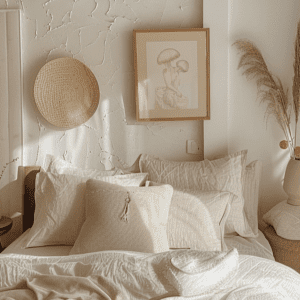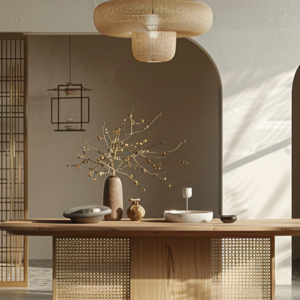Ever found yourself standing in the bedding aisle, torn between a duvet cover and a comforter? We get it. Choosing the right bedding can be daunting and a head-scratcher. But don’t worry in this blog post, we’ll break down the nitty-gritty of duvet covers vs comforters, so you can make the bedtime choice that suits you best. No fluff, just the facts. Let’s dive in!
Duvet Cover vs Comforter: The Basics
What is a Duvet?
Often referred to as a duvet insert, it’s a soft and cozy blanket that typically consists of a fabric shell filled with down, feathers, or synthetic materials. They come in various sizes and are designed to fit inside a duvet cover, which serves both a decorative and protective purpose.
Advantages of Using a Duvet Cover
Easy Style Updates: Change the look of your bedroom by simply swapping out your duvet cover.
Protection: Keep your duvet clean and free from dust and stains.
Customization: Choose from a wide variety of designs to match your bedroom decor.
Disadvantages of Duvet Covers:
More pieces to manage: Duvet covers require both the duvet insert and the cover itself, which can be more maintenance.
Learning curve: Some people find it challenging to insert the duvet into the cover properly.
Cost: Duvet covers can be relatively expensive, especially when paired with a high-quality duvet insert.
What is a Comforter?
On the other hand, these are a standalone bed covering filled with insulation, which can be made from down, feathers, cotton, or synthetic materials. They are typically stitched or quilted to keep the filling evenly distributed.
Advantages of Comforters:
Simplicity: Comforters are ready to use, requiring no additional covers or inserts.
Warmth: They are designed to provide substantial warmth, making them perfect for colder climates.
Variety: Comforters come in a wide range of designs and patterns, offering options for various bedroom aesthetics.
Cost-effective: In some cases, comforters can be more budget-friendly than duvet covers with high-quality inserts.
Disadvantages of Comforters:
Cleaning challenges: Comforters can be bulky and may not fit in standard washing machines, making cleaning more difficult.
Limited customization: Unlike duvet covers, you can’t easily change the look of your bedding without purchasing a new comforter.
Durability: Comforters may not last as long as duvets, as they are more susceptible to wear and tear.
Key Differences
1. Versatility
Duvet: Duvets offer versatility as they can be easily customized to fit your preference by selecting a duvet cover with various designs and materials.
Comforter: Comforters are usually one-piece, which limits their ability to change the appearance of your bedding without additional covers.
2. Maintenance
Duvet: Duvets are known for their ease of maintenance since they are machine-washable. Cleaning a duvet cover is more convenient than laundering a comforter.
Comforter: Comforters can be bulkier and may require professional cleaning, making them less convenient in terms of maintenance.
3. Warmth
Duvet: The warmth of a duvet depends on the filling material. Down-filled duvets offer excellent insulation, making them perfect for cold climates.
Comforter: Comforters also vary in warmth, but they tend to be more standardized and might not offer as much control over temperature.
Factors to Consider
Consider the following factors while deciding which one is the better option for you:
1. Climate is the number one reason, because if you live in a colder region, comforter might be a better option for you due its insulation, while a lightweight duvet could be an ideal choice for warmer regions.
2. If you or someone in your family suffer from allergies, make sure the duvet or comforter you’re opting for is hypoallergenic.
3. Style and decor is another factor that you might want to consider when deciding between the two. Think about your bedroom’s decor and the visual appeal you want to achieve and based on that make a choice. But also keep in mind that duvets offer a broader range of design options with the choice of duvet covers.
4. Ultimately, your personal preference and comfort should be the deciding factor. Experiment with both the options to find out which one provides you with the best sleep experience.
Types of Duvet Covers

1. Cotton duvet covers are a popular choice due to their natural breathability and durability. They come in various thread counts, with higher thread counts offering a smoother and more luxurious feel.
2. Linen Duvet Covers are known for their exceptional moisture-wicking properties and elegant, textured appearance. They’re perfect for a relaxed, laid-back bedroom vibe.
3. Microfiber duvet covers known for their softness and resistance to wrinkles are also a cost-effective option. They’re easy to maintain and come in a wide range of colors and patterns.
Types Of Comforter

1. Cotton Comforter are filled with cotton fibers, making them breathable and suitable for warmer seasons. They are easy to maintain and are often machine-washable.
2. All-Season Comforters are designed to be versatile providing the right level of warmth for most of the year. These are suitable for people who dont want to switch their bedding with the changing seasons.
3. Baffle-Box Comforters have a unique construction with internal walls or boxes that prevent the filling from shifting. They maintain an even distribution of warmth.
4. Down Comforters are filled with duck or goose down, these comforters are known for their exceptional warmth and lightweight feel as these are excellent for cold climates, as they provide excellent insulation.
Choosing the Right Duvet Cover Or Comforter Size
Duvet Cover Size
Measuring your duvet insert is the first step. Most duvet inserts come in standard sizes, such as Twin, Full/Queen, and King.
Decide how much “drop” or overhang you want on the sides and foot of your bed. The standard drop is around 12 to 20 inches on each side, so make sure to add this drop measurement to the dimensions of your duvet insert.
Consider bedding style, if you prefer a more relaxed or casual look, you can opt for a larger duvet cover that provides a more generous drop. However, for a neater and more tailored appearance, choose a duvet cover that fits snugly.
Comforter Size
Determine the bed size, as the size of the comforter hould align with the size of your bed.
Similar to duvet covers, decide on the amount of drop you want. The standard drop for comforters is also the same as the drop of duvet covers. So make sure to add this drop measurement to the dimensions of your bed.
Check for specific sizing as there are some comforters which may come in alternative sizing, such as “Oversized Queen” or “California King.”
If you’ve exceptionally thick mattress, it’s important to select a comforter with extra dimensions just to ensure that it covers the entire bed, including the sides and foot.
The style of your bedding also matters. A comforter that is too small may not drape nicely over the edges of your bed, affecting the overall appearance.
Caring for Your Duvet Cover And Comforter
Duvet Cover Care
- Machine wash the duvet cover regularly, make sure to follow the care label instructions. Use cold water and a mild detergent to prevent color fading.
- Before washing, ensure the duvet cover is completely closed (zipper or buttons) to prevent the duvet insert from slipping out.
- Always make sure that you wash the duvet cover separately or with similar colors to avoid damage from friction. Plus use a gentle cycle to protect the fabric and stitching. Avoid harsh detergents or bleach, as they can damage the fabric.
- Tumble dry the duvet cover on a low or delicate setting to prevent shrinkage. Remove promptly to prevent wrinkles and maintain the fabric’s integrity.
- Iron on a low heat setting if wrinkles persist, but be cautious to avoid damaging the fabric.
- When not in use, store the duvet cover in a cool, dry place to prevent dust and dirt accumulation. Consider using a breathable fabric storage bag for protection.
Comforter Care
- Always refer to the care label on your comforter for specific cleaning instructions based on the material and filling.
- To maintain loft and even filling distribution, fluff your comforter regularly by shaking it and redistributing the filling inside.
- Address small stains or spills promptly by spot cleaning with a mild detergent and a soft cloth or sponge. Avoid saturating the fabric.
- For delicate comforters, professional cleaning may be recommended. Follow the care label’s instructions.
- If your comforters are machine-washable, we suggest you to use a large-capacity machine on gentle cycle with cold water and a mild detergent. Make sure to rinse it thoroughly to remove detergent residue.
- Tumble dry on low heat to maintain the integrity of the comforter. Adding clean tennis balls or dryer balls can help fluff the filling and distribute it evenly.
- Avoid prolonged exposure to direct sunlight, as it can fade the colors of your comforter. Store it away from direct sunlight when not in use.
- Protect your comforter by using a duvet cover as they are easier to clean and replace, preventing direct contact with stains and spills.
Interior Design And Bedding
We all know the choice of our bedding plays an important part on the overall design and aesthetic of our bedroom, and if by any chance you’re into interior designing as much as we’re, we understand how important and crucial it is to align the two things; our bedding choice with the vision we’ve for our space.
For example, Scandinavian bedroom furniture is known for its clean lines, simplicity, and functionality. So in a setting like this, a crisp white duvet cover with a minimalist design can easily complement your furniture beautifully, creating a cohesive and tranquil look.
On the other hand, if you are more inclined towards contemporary spaces, a colorful and textured comforter can easily add a pop of personality to your bedroom. It can even be a focal point in your room’s design.
So honestly I feel like in this debate of duvet cover vs comforter, there’s no one-size-fits-all answer. Your choice should be based on your personal preferences, lifestyle, and bedroom design. Duvet covers offer flexibility and customization, while comforters provide simplicity and warmth.
Consider your needs and the aesthetics of your bedroom to make the right decision. Ultimately, both options can contribute to a comfortable and inviting sleeping environment.
Remember that your bedding choice is just one element of your overall interior design. Whether you’re drawn to a Scandinavian or contemporary style, your bedding can be a focal point in creating a beautiful and harmonious bedroom.
Now that you’re well-informed about the differences between duvet covers and comforters, you can confidently select the bedding that suits your lifestyle and design aspirations.














